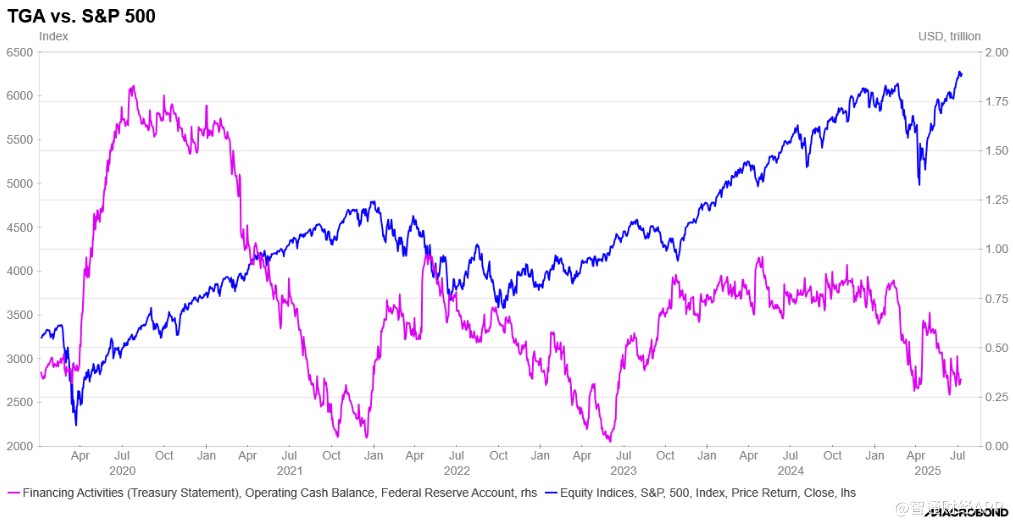
Is the alert on U.S. Treasuries lifted, leading to a major crisis? A liquidity "tsunami" of $500 billion is heading towards U.S. stocks!

美國股市可能面臨 5000 億美元的流動性衝擊,因美國債務上限危機暫時緩解。國會提高了借款上限,預計未來 10 年將增加 3.4 萬億美元的國家債務。財政部總賬户 (TGA) 重建可能收緊市場流動性,給股市帶來壓力。預計 TGA 在 7-9 月季度的最終價值將達到 8500 億美元,若完全重建,流動性將減少 5100 億美元。
智通財經 APP 獲悉,隨着美國總統特朗普推動的 “大而美” 税收與支出法案驚險通關眾議院,美國債務上限危機暫時緩解,但是一場關鍵的轉變正在發生,美國股市可能面臨 5000 億美元的流動性衝擊。
據瞭解,作為 “大而美” 法案的一部分,美國國會議員將美國政府 36.1 萬億美元的借款上限提高了 5 萬億美元,此舉暫時緩解了人們對美國債務短期內違約的擔憂,但使美國的長期債務問題更加嚴重。無黨派機構美國國會預算辦公室 (CBO) 預計,這項法案將在未來 10 年內增加 3.4 萬億美元的國家債務。
美國政府的結算賬户,即所謂的財政部總賬户 (TGA),在債務僵局期間被抽乾,截至 7 月 8 日已降至約 3400 億美元,而 2 月 11 日約為 8400 億美元。如今,TGA 重建工作已經開始,這可能會收緊流動性狀況。
TGA 重建或收緊市場流動性
美國財政部在達到債務上限後無法再發行新債,因此只能動用 TGA 來填補政府支出缺口。隨着債務危機緩解,TGA 將進行重建,這可能會大幅降低市場流動性,從而給美國股市帶來壓力。
TGA 在美聯儲的資產負債表中扮演着至關重要的角色。由於它是資產負債表中最重要的變動部分之一,當 TGA 的價值下降時,有助於增加美聯儲持有的準備金餘額;而當 TGA 上升時,則會減少準備金餘額。
根據 4 月份會議的季度再融資文件,預計 TGA 在 7-9 月季度的最終價值將達到 8500 億美元。美聯儲會議紀要也指出,一旦債務問題得到解決,TGA 很可能很快得到重建。
根據資管公司 Mott Capital 創始人 Michael Kramer 的估計,如果 TGA 全部重建,則意味着到 9 月底會將有大約 5100 億美元的流動性流失,美聯儲準備金可能將降至 2.7 至 2.8 萬億美元。即使考慮到逆回購工具的使用,美聯儲準備金也可能降至 2.9 至 3.0 萬億美元。
總而言之,隨着大規模的 TGA 重建,美聯儲準備金餘額可能減少 4000 億至 5000 億美元,這可能會對市場流動性及保證金可用性造成壓力。
對美國股市有何影響?
一般來説,過去每當準備金餘額上升或下降時,整個市場的保證金水平會發生變化。值得關注的是,標普 500 指數、保證金以及準備金餘額通常會呈現出同步的趨勢,因此,準備金餘額大幅減少很可能對保證金餘額產生負面影響,從而對股市產生負面影響。
從歷史上看,TGA 重建對標普 500 指數產生負面影響

從歷史上看,2022 年 1 月 TGA 的重建以及逆回購活動的增加導致準備金餘額大幅減少,從而給保證金水平和標普 500 指數帶來壓力。
然而,TGA 上一次重建是在 2023 年夏天,當時並未對股票市場產生影響,因為逆回購工具正在耗盡,補充了系統中的準備金。
Kramer 警告稱,鑑於逆回購目前已接近低點且不太可能進一步下降,量化緊縮 (QT) 政策仍在持續,同時 TGA 即將重建,預計準備金將會下降。理論上,隨着 TGA 增加和準備金餘額降至約 3 萬億美元甚至更低的水平,流動性預計將會枯竭。

